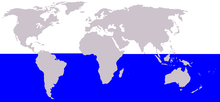| Antarctic minke whale[1] Temporal range: [2]
| |
|---|---|

| |
| Antarctic minke whale in Ross Sea | |

| |
| Size compared to an average human | |
| Scientific classification | |
| Domain: | Eukaryota |
| Kingdom: | Animalia |
| Phylum: | Chordata |
| Class: | Mammalia |
| Order: | Artiodactyla |
| Infraorder: | Cetacea |
| Family: | Balaenopteridae |
| Genus: | Balaenoptera |
| Species complex: | Minke whale species complex |
| Species: | B. bonaerensis
|
| Binomial name | |
| Balaenoptera bonaerensis Burmeister, 1867
| |

| |
| Antarctic minke whale range | |
The Antarctic minke whale or southern minke whale (Balaenoptera bonaerensis) is a species of minke whale within the suborder of baleen whales. It is the second smallest rorqual after the common minke whale and the third smallest baleen whale. Although first scientifically described in the mid-19th century, it was not recognized as a distinct species until the 1990s. Once ignored by the whaling industry due to its small size and low oil yield, the Antarctic minke was able to avoid the fate of other baleen whales and maintained a large population into the 21st century, numbering in the hundreds of thousands.[5] Surviving to become the most abundant baleen whale in the world, it is now one of the mainstays of the industry alongside its cosmopolitan counterpart the common minke. It is primarily restricted to the Southern Hemisphere (although vagrants have been reported in the North Atlantic) and feeds mainly on euphausiids.
- ^ Mead, J. G.; Brownell, R. L. Jr. (2005). "Order Cetacea". In Wilson, D. E.; Reeder, D. M. (eds.). Mammal Species of the World: A Taxonomic and Geographic Reference (3rd ed.). Johns Hopkins University Press. pp. 723–743. ISBN 978-0-8018-8221-0. OCLC 62265494.
- ^ "Fossil works".
- ^ Cooke, J.G.; Zerbini, A.N.; Taylor, B.L. (2018). "Balaenoptera bonaerensis". IUCN Red List of Threatened Species. 2018: e.T2480A50350661. doi:10.2305/IUCN.UK.2018-1.RLTS.T2480A50350661.en. Retrieved 13 November 2021.
- ^ "Appendices | CITES". cites.org. Retrieved 14 January 2022.
- ^ Branch, T. A. (2006). "Abundance estimates for Antarctic minke whales from three completed circumpolar sets of surveys, 1978/79 to 2003/04". Paper SC/58/IA18 submitted to the International Whaling Commission Scientific Committee, pp. 1–28.
